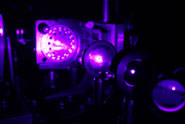Optical circuit enables new approach to quantum technologies
25 Jun 2011
An international research group led by scientists from the University of Bristol, UK, and the Universities of Osaka and Hokkaido, Japan, has demonstrated a fundamental building block for quantum computing that could soon be employed in a range of quantum technologies.
 |
| The component the team have built uses particles of light, photons, to encode quantum mechanical information Image by J.C.F. Matthews |
Professor Jeremy O'Brien, Director of the University of Bristol's Centre for Quantum Photonics, and his Japanese colleagues have demonstrated a quantum logic gate acting on four particles of light – photons.
The researchers believe their device could provide important routes to new quantum technologies, including secure communication, precision measurement, and ultimately a quantum computer - a powerful type of computer that uses quantum bits (qubits) rather than the conventional bits used in today's computers.
Unlike conventional bits or transistors, which can be in one of only two states at any one time (1 or 0), a qubit can be in several states at the same time and can therefore be used to hold and process a much larger amount of information at a greater rate.
''We have realised a fundamental element for processing quantum information - a controlled-NOT or CNOT gate - based on a recipe that was theoretically proposed 10 years ago,'' said Professor O'Brien. ''The reason it has taken so long to achieve this milestone is that even for such a relatively simple circuit we require complete control over four single photons whizzing around at the speed of light!''
The approach taken by Professor O'Brien and his colleagues combined several methods for making optical circuits that must be stable to within a fraction of the wavelength of light, that is, nanometres. In 2001 optical quantum computing became possible when a theoretical recipe for realising this CNOT gate, as well as the other necessary components, was developed.


.webp)




























